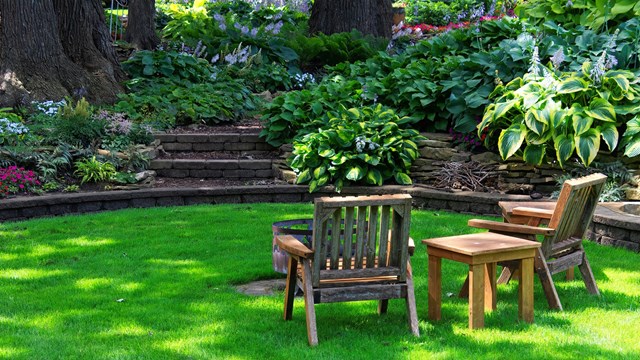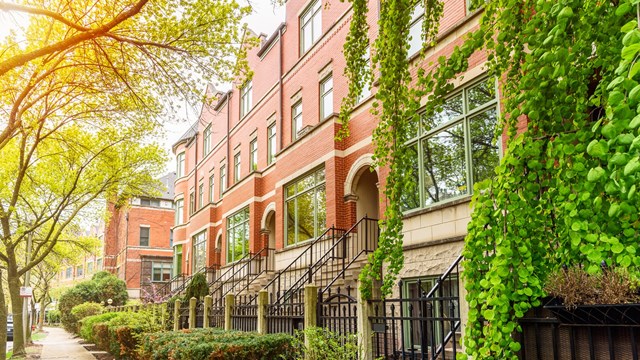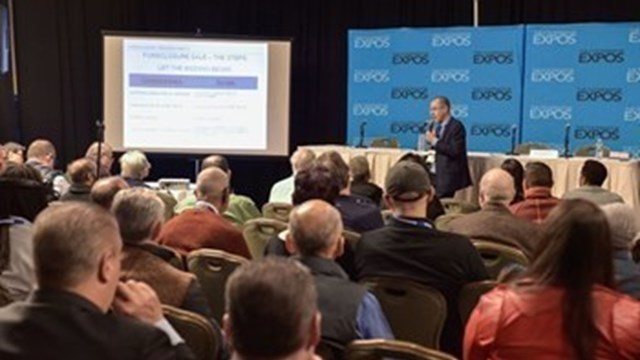In a city known for its expanses of steel and concrete, it can be easy to forget the importance that greenery plays in the life of Chicago residents. For many co-op and condo residents, the flowers, shrubs, grasses and trees that surround their buildings, fill their courtyards and spill gently from their balconies soften the edges of urban living and bring colorful life to a sometimes monochromatic landscape.
The selection, planting and care of those oases of green can be a significant undertaking, one that requires a solid understanding of what plants and flowers will thrive in an urban environment and avoiding those that simply will not.
A Tree Grows in …
“Trees enhance urban living in vital ways,” says Dr. Andrew Bell, curator of woody plants at the Chicago Botanic Garden. “They absorb sound and pollutants, and keep our cities cooler in the summer. Cities are not as kind to their trees. The urban environment puts many stresses on our trees.”
Specifically, Bell cites a number of issues that can impact the health and well-being of a city tree. For example, “many street trees are the victims of vandalism,” he said. “Trees help keep city air clean, but in so doing, they absorb pollutants that can undermine their health. Reflected sunlight from buildings and asphalt can increase the heat loads to stressful levels. City trees are also often asked to grow in less than ideal locations and under less than optimal planting conditions. Poorly draining sites can leave a tree standing in water, making it difficult for the tree to breathe.”
Jenna Jones, ASLA, LEED Green Associate, of Site Design Group, Ltd., in Chicago, agrees that city life can be a significant challenge for trees, shrubs and flowers. “Plants in Chicago are challenged by a number of difficult conditions, including our dramatic temperature changes, air quality (pollution), wind exposure, salt from roads and walkways, and people,” she says. “Curbs or raised beds that separate the plants from some of these conditions in addition to thoughtful planning and placement of plants and planting beds can help contribute to their success.”
Starting Out on the Right Foot
With careful planning, though, a great many of those vulnerabilities can be avoided. “First and foremost, property owners should select trees that are suitable to site conditions so that they will live and be healthy,” Bell says. “Trees and shrubs in poor health regardless of what they are will not be attractive.”
It is important to try and predict potential issues with certain types of trees. “Important factors to consider are a tree’s adaptability to urban landscaping conditions and regionally specific environmental conditions.” Bell says. “Most urban landscapes are similar in having heavily compacted soils with low fertility. Additionally, some regionally specific factors should be considered, such as tolerance to salt spray in northern regions where snowfall is high.”
Thinking ahead to when the tree is full-grown can also affect the health of a building’s greenery. “The mature size of the tree in both width and height should be compared with the available space at the planting site,” Bell says. “Trees with prolific fruit, seeds and leaf fall can create maintenance issues for some property owners. Regional infestations of pests and disease are also an important consideration. Learn about threats to your area’s trees—such as the emerald ash borer in the Midwest—and look for tree species unaffected by the problem.”
Jones encourages boards and building managers to consult with professional landscape designers before embarking on any sort of ambitious—or even modest—green additions. “It’s always helpful to consult a professional in planning your landscape to ensure you are designing and installing the best possible landscape,” she says.
Jones agrees that those early discussions must focus on matching the right plant with the right environment. “It’s important to select plants that are suited to the conditions you are planting in, which can include sunlight, soil moisture, proximity to roads, maintenance, etc.,” she says. “Conduct an in-depth analysis of the conditions before creating your planting plan to ensure you are selecting the best-suited species for your site.”
Choosing the Right Plants and Trees
Certain characteristics can help a tree, shrub or flower grow and even thrive in the rough and tumble world of a Chicago street. “In an urban setting, plants that are hardy, drought-tolerant—can thrive without irrigation—and can withstand the urban climate, including salt and pollution tolerance, will be the most successful,” Jones says. “Often evergreens offer the hardiest varieties of plants, but do not offer much color or interest. Contrasting structural plants such as evergreen with showy perennials or bulbs can have a big impact.”
And if there are hesitations on which plants might work best, Jones suggests turning to the city itself. “Larger cities—including Chicago—often offer a list of acceptable plants for public open spaces that can be used as a guide for species selection,” she says.
Bell says that “trees that are adapted to compacted soils tend to do better in a city environment.” Specifically, he says, “these are typically trees known as riparian species, those that grow naturally along streams and riverbanks.”
Bell’s research work includes an analysis on the effects of climate change on trees in Midwestern cities, and he has identified a number of species that will do will in the potential environmental shifts that may emerge in the coming decades. He predicts that “the Autumn Gold ginkgo will thrive through 2050. Two types of elms resistant to Dutch elm disease—the Valley Forge American elm and Accolade elm—and the Village Green Japanese Zelkova—also proved suitable to the Midwest through 2050.”
Plants to Avoid
Just as certain greenery will thrive in an urban setting, others have the cards stacked against them from the get-go. Or they may end up harming the environment around them or causing more disruption and maintenance needs than the building may want to undertake.
“Avoid plants that are not suited to the Plant Hardiness Zone of Chicago—5b—as they will likely not survive the climate,” says Jones. “And steer clear of temperamental, high maintenance plants that will require a lot of attention and very specific conditions to succeed.”
In addition, Jones suggests trying always to “avoid plants on the state of Illinois invasive species list, as these plants will grow and reproduce quickly, and can disrupt or take over native plant communities. You can check the Department of Natural Resources for a complete list of invasive species.”
“Drought and heat-sensitive species,” adds Bell, “and those not adaptable to compacted, low fertility soils will struggle in many urban environments. Based on my research, I do not recommend the American Linden, Amur maackia, Black Hills Spruce, Norway Spruce and Serbian Spruce for the Chicago metropolitan area.”
Once the plant choices have been made—or actually, even well prior to that step —a discussion about maintenance needs to take place between designers, boards and building staff because no plant or tree, no matter how healthy or well-suited to urban life, will live and flourish without good, regular maintenance.
“A tree needs a lot of followup care during its first year or so, particularly regular watering,” says Bell. “Once a tree is established, property owners may need to prune branches for the safety of pedestrians, cars and other property.”
“It’s incredibly important to create a maintenance and management plan at the onset of your project,” Jones says. “This will ensure you have the budget and staff to contribute to a successful landscape prior to implementation, and will help you create the appropriate expectations for your landscape. When selecting plants, making sure your maintenance and management plan can accommodate the requirements of the species you select, will help you choose the best-suited plants for your site.”
Steady and proper maintenance is also a key factor in helping plants reach their potential. “It’s important to understand that plants need cultivation and time to get to their full capacity,” Jones says. “For ornamental grasses and perennials, we typically tell clients to expect at least two growing seasons for the plants to reach their full potential. In the establishment period, you can supplement your perennials with interspersed annuals for an immediate impact. For trees and shrubs, the larger the size you are able to plant initially, the faster they will reach their capacity and the quicker they will show off their attributes, such as blooms, fall leaf color and fragrance.”
For an Extra Eye-Catching Splash
Certain plants can help tell a story by underscoring a building’s personality or the face it wants to put forward to potential residents. One way to rise above the competition is to ensure a healthy, colorful look throughout the year.
“Trees that offer multiple seasons of interest, such as the Eastern Redbud and Cornelian Cherry Dogwood, can be especially appealing,” says Bell. “One of my favorite trees for urban environments is the Kentucky Coffeetree. The Bald Cypress is another.”
That multi-season appeal is also high on the wish list for Jones. “Most people focus on plants that thrive in the summer months, but considering plants that have an attractive attribute in at least three seasons can contribute significantly to the curb appeal of the landscape,” she says. “For example, plants with vibrant fall leaves, brightly colored twigs in the winter to contrast the snow, or fragrant, showy flowers in the spring can make a big statement and will be noticed. It’s also important to plant a variety of species with varying attributes throughout the year in order to create a landscape that is always changing and interesting to the visitor.”
And there is a real science to choosing the best, heartiest and most eye-catching trees, shrubs and flowers to accent and enhance any residential space. With the right experts and an understanding of all the work, energy and yes, love, needed to keep these fragile flora healthy, there’s no limit to the beauty that can add to any building.
Elizabeth Lent is a freelance writer and a frequent contributor to The Chicagoland Cooperator.







Comments
Leave a Comment